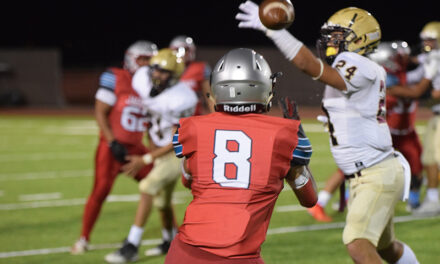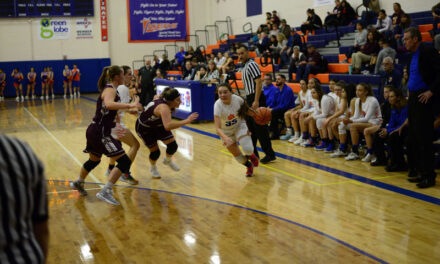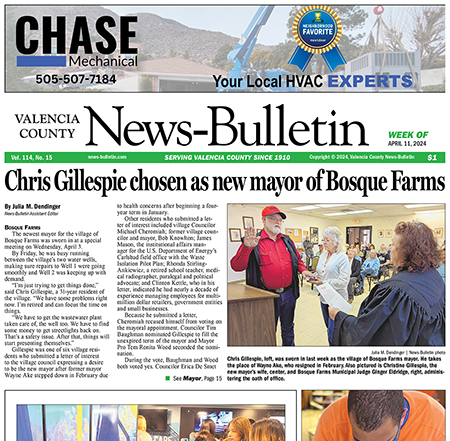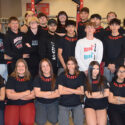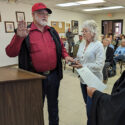(La Historia del Rio Abajo is a monthly column written by members of the Valencia County Historical Society. Readers are encouraged to share memories about the topics of recent columns or suggest future columns by calling Richard Melzer, La Historia’s editor, at the University of New Mexico-Valencia Campus, 925-8620, where he teaches New Mexico history. Readers are also invited to join the historical society by calling 861-0581.)
(The author would like to thank Art Aragon, Eric Baca, Ambrose Aragon, Manuel Aragon, Stella Aragon, Norm McDonald and Matt Baca for their generous help in preparing this month’s column.)
Last month’s La Historia del Rio Abajo traced the mercurial rise and professional success of Art Aragon, a Belen native who was an established star in the boxing world by the early 1950s. Art was so successful and drew so much attention that he was known in the press and in the ring as the Golden Boy.
But, as with most athletes, Art had his share of defeats and controversy. In fact, controversy seems to have shadowed Art nearly everywhere he went in his personal and professional lives.
This was certainly true in 1951. Three months after beating lightweight champion Jimmy Carter in a non-title fight in August, 1951, Art faced the black New Yorker in a rematch that Art still calls the biggest fight of his life.
The 15-round scheduled match received great publicity and was broadcast on nationwide radio, including on station KFFM in Albuquerque. All of Valencia County listened, especially Art’s two brothers, Camilo and Tony, who still lived in Belen. Also broadcast on national television, it was the first championship boxing match shown live on coat-to-coast TV.
But Art’s Nov. 14, 1951, fight against Jimmy Carter went poorly from the start. Art had difficulty getting down to lightweight status, having to nearly live in a steam bath to reach 135 pounds before weigh-in time. By fight time, Art was so weak that he claims that he was the only fighter who ever had to be carried into a ring.
The results were sadly predictable. A disappointed News-Bulletin reporter summarized the fight by saying, “A courageous Art Aragon, who fought valiantly but often wildly, lost an unanimous 15-round decision” as he was hit “unmercifully during much of the last five rounds” of the match. Borrowing from a famous baseball poem, the same reporter wrote:
“Ah, somewhere in this favored land the sun is shining bright;
The band is playing somewhere, and somewhere hearts are light.
And somewhere men are laughin, and somewhere children shout;
But there is no joy in Bethlehem, Belen’s Artful Art has lost out.”
Art’s other major defeat came three years later when he faced Vince Martinez of Paterson, N.J. On this occasion, 17,158 fans crammed into L.A.’s Gilmore Field on a warm summer evening. Referred to as the Great Mouthpiece by the press, Art confidently predicted, “I’ll knock the bum out in four rounds.”
But Art was too optimistic. Art managed a solid left to Martinez’s jaw in the fifth round, but that was the best he could do in the 10-round match.
Simply put in the press, Art “was the victim of a hopeless, horrible beating.” Both his eyes were damaged and his nose was broken as early as the second round. Sports page photos attest that his face was a “bloody mess” by fight’s end.
The decision against Art was unanimous. Martinez credited Art by saying, “He’s got lots of heart and is real strong.” Wearing dark sunglasses to cover his bruised eyes, the usually talkative Aragon said nothing as he exited Gilmore Field and drove away.
Boxing experts predicted that Art’s 1954 thrashing would end his career in the ring. It probably should have, as Art is the first to admit today. “I should have retired five years before I did,” Art says.
Instead, the Golden Boy fought on, often surrounding himself with controversy by what he said as well as by what he did. Once, when his bitter foe, Lauro Salas, tried to make amends in a popular L.A. restaurant, Art spurred the peace offering. Art recalls that an angered Salas “hit me several times while I was taking off my overcoat, and then we got going. The cops came in, and I invited them into the brawl, but they wouldn’t join us. Then I polished Salas off.” The newspapers ran a far different account of the incident by interviewing Salas only.
Art was once described as the “straw that stirs the drink.” In mid-1956, he “stirred” the boxing world by being charged with wearing an illegal eye patch in the late rounds of a fight he won in L.A. After another controversial fight, the Los Angeles City Council took the unprecedented step of taking sides in the disputed outcome, voting against Art and creating new headlines for the press.
Art got into far more trouble in 1957 when he was accused of offering a boxer $500 to take a dive in the fourth round of their scheduled Dec. 18 fight in San Antonio, Texas. Hearing the charges prior to the match, Art claimed that he was too ill to fight and went directly home to Los Angeles. He was, nevertheless, brought to trial, convicted and sentenced to one to five years in prison.
Still professing his innocence, Art won an appeal for a new trial. Hearing the appeal verdict, Art’s manager wired the good news in a two-word telegram: “Justice triumphs.” Art reportedly replied with a two-word message of his own: “Appeal immediately.” All charges against Art were eventually dismissed.
Art finally knew it was time to hang up his gloves when, in his last fight on Jan. 21, 1960, “I hit the other guy on the chin and I went down.” Acknowledging that boxing is an extremely dangerous occupation, Art admits he was fortunate not to have suffered more injuries. Besides the broken nose he suffered in the Vince Martinez’s fight, Art’s only other injury was a broken knuckle suffered in a June, 1952, fight against Joey Barnum in Albuquerque. Knowing how lucky he was, Art still says, “All my life, I was scared I’d kill somebody in the ring — me!”
Although he suffered relatively minor physical injuries, Art does worry about the damage that countless blows to his head have had on his memory. He often defers to his friend Eric Baca for details about the past. But he even jokes about his memory loss, telling at least one interviewer, “I have a great memory. Er, what’s your name?”
When Art finally did retire, he considered new careers in real estate sales or professional golf.
He even tried his hands at acting, with roles in a half a dozen movies filmed both before and after he left boxing. His biggest role was as a fighter in the movie, “A Street With No Name.” But Art knew that his acting potential was limited. He claims that he never could remember his movie lines anyway. In one movie, his two-word line was, “I will,” but, after days of practice, he says it came out, “Will I?’
At one point, someone suggested that Art use his highly recognizable name to open a bail bond business. Art took the suggestion and opened Golden Boy Bail Bonds in Van Nuys, Calif. His business card featured a picture of himself in a boxing pose and the words, “I’ll get you out of jail if it takes 10 years!”
Now in his 70s, Art has all but retired from his business career, letting his son Brad run the bond business most of the time. He still goes into the office once or twice a week to see how things are going but spends more time with his fancy cars and with his good friend, Audrey. (Art was married four times.) He likes to travel and is pleasantly surprised when someone overseas still recognizes him as the famous Golden Boy of boxing history.
Although he realizes that boxing was good to him over many years, Art has few fond memories of fighting. As early as 1954, he told a Saturday Evening Post writer that “I don’t like the fight game. I don’t like fighting. I don’t like fighters. You can believe this or not, but I never watch a fight on television, never listen to one on the radio and never go to one unless I have a good reason to. I don’t like fightgoers. I don’t like fight writers. I don’t like fight hangers-on. I don’t like any of it. I only like the money — to support me in the manner to which I have grown accustomed.”
Years later, in retirement, he had the same feelings, although when pressed about what he missed most about fighting, he didn’t mention money. By then, he said he simply missed “the broads.”
In 1990, Art was proud to be inducted into the World Boxing Hall of Fame. The program at the induction ceremony acknowledged that Art never won a world championship, but “Art could punch. He could take it. He had guts.” The program also noted that Art “always put on a show.” As a result, “he could draw more fans and more money to a club fight than could most world champions in a title match.”
The 1990 induction ceremony program could have added something more about Art’s life that makes him a world class person. It could have said that Art was a loyal friend. He has remained close to his lifelong friend, Eric Baca of Albuquerque, and the two talk by phone or visit often. Eight-hundred of his friends came out to a dinner in his honor held in Albuquerque on Dec. 30, 1990.
Art was particularly loyal to his friend Frankie Gallegos of Albuquerque. When Frankie was dying of heart disease in Albuquerque’s Veterans Hos-pital, he continuously refused to have an operation that could save his life.
Then Art and Eric appeared at Frank’s bedside. Art spoke to his boyhood pal and went so far as to promise him that he’d take him to New Orleans, Mexico, Europe or anywhere if Frankie agreed to have the needed operation.
Frankie took’s Art’s offer, had the operation, survived and traveled with Art to all the places the Golden Boy had promised to take him. Frankie lived 15 more years, when the doctors had given him only hours to live if he had not had the heart operation in time.
On a trip home to New Mexico in the early 1950s, Art told an Albuquerque newspaper reporter that boxing fans “come to see me get killed” because he was always cast as the bad boy, the villain in the press. “I have to work hard to be a villain” and sell tickets to standing-room-only crowds. “Of course,” he quipped, “underneath, all the time, I have a heart of gold.” As with most of what he says, the Golden Boy was only half kidding.
Much has changed in the 40 years since Art retired from the ring. His boyhood home on Second Street in Albuquerque has been replaced by a fine new house, and the railroad yards across the street are largely silent. Legion Stadium in Los Angeles, where Art rose to boxing fame, is now a fitness center. And a colorful, often-controversial young Hispanic fighter named Oscar de la Hoya is now known as the Golden Boy of California and the boxing world.
But before there was a de la Hoya or an Ali or a Johnny Tapia or a Danny Romero, there was an Art Aragon who helped pave a wide, usually-lucrative path in sports. All who have traveled that path have profited in fame and fortune. For this, and his many other achievements, Art Aragon of Valencia County will always be the charmed Golden Boy of professional boxing.
(Editor’s note: Richard Melzer is aprofessor of history at the University of New Mexico-Valencia Campus and a longtime member of the Valencia County Historical Society.)
LA
HISTORIA
DEL RIO ABAJO
The Valencia County News-Bulletin is a locally owned and operated community newspaper, dedicated to serving Valencia County since 1910 through the highest journalistic and professional business standards. The VCNB is published weekly on Thursdays, including holidays both in print and online.


